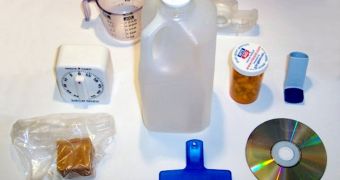One of the main goals for research in the United States today is the conversion of carbon dioxide emitted by fossil fuel-powered electrical plants into useful products. As part of this endeavor, the US Department of Energy (DOE) is providing $106 million (£68 million) in research grant money to six companies that are engaged in performing such research. One of these organizations is Massachusetts-based Novomer, which is currently developing a way of turning the dangerous greenhouse gas into plastics.
If the endeavor succeeds, the benefits could be twofold. On one hand, the gas would no longer be released into the atmosphere, where it contributes to increasing the effects of global warming, and also to making the planet's oceans more acidic. Rather, it would be put to good use, producing materials that are needed around the world. Additionally, producing plastics from CO2 would eliminate the need for more oil to be extracted. Generally, plastics are obtained from hydrocarbons derived from oil. This si why the DOE is so interested in the work performed at Novomer.
The research there has already been awarded no less than $18.4 million in federal funding. Experts at the company say that producing polycarbonate polymers is possible. The company's approach to completing the DOE objective is rather simple – combine traditional epoxide feedstocks with carbon dioxide produced by power plants. The resulting plastics would contain between 40 and 50 percent carbon, thus constituting an effective (and useful) method of capturing and storing the dangerous chemical. Novomer experts have been working on improving this process for the past four years.
“We are very positive about this technology because it is so sustainable, but from a cost and performance point of view the technology is also very attractive,” told Chemistry World Jan Besamusca. He is the innovation director of the NeoResins+ division at the Dutch life sciences and materials company DSM. Novomer is working with this corporation on developing low molecular weight (MW) polymers, using carbon dioxide as a raw material. After 3 years of working together on this technology, the two companies reached what they termed a “major breakthrough” this January
Representatives from the American company also emphasize that they agree with the DOE's decision of searching for alternatives to carbon capture and storage (CCS) schemes. “It would be a much better use of carbon dioxide to turn it into something a company can develop a business around, rather than relying on government subsidies to bury it,” says Novomer's chief executive, Jim Mahoney.

 14 DAY TRIAL //
14 DAY TRIAL //